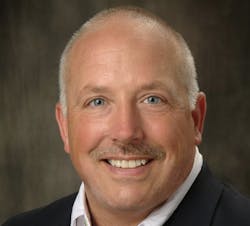Roy Kok joined CESMII as marketing director in August 2020. He has more than 30 years of experience in industrial automation, ranging across both hardware and software. His areas of expertise include data acquisition, PLCs, HMI/SCADA, historians and analytics solutions across all vertical industries. He has worked with research companies for industry and held evangelist roles for product companies and standards organizations. He plans to bring an extremely broad perspective of industry needs and position CESMII as the clear solution for enhancing the competitiveness of U.S. manufacturing. Kok holds a bachelor of science degree in electrical engineering from Northeastern University and resides in Massachusetts, either at his home or on his trawler, RyKa.
What are three key things that a machine builder, system integrator or manufacturer should know about your company?
Roy Kok, marketing director, CESMII—The Smart Manufacturing Institute: CESMII is on a mission to change the world of manufacturing for the better, in one major step, the introduction of standards and example technologies to deliver application plug-and-play. The goal is to democratize smart manufacturing for all enterprises, large, but especially the small and medium companies that make up more than 98% of the market. The opportunities of Industry 4.0 and smart manufacturing are largely out of reach, due to the cost and complexities of adoption.
CESMII is delivering technology, but also assisting customers with education and networking with peers that are on the same journey.
Every company, end user, system integrator and product vendor should become a member of CESMII, a government-funded, nonnprofit institute specifically for their benefit.
What new technologies are driving your product development and why?
Roy Kok, marketing director, CESMII—The Smart Manufacturing Institute: We’re looking to deliver existing cloud-based technologies in ways that manufacturers can feel comfortable with, decreasing infrastructure costs, while ensuring security through modern encryption practices and safety by taking a read-only approach to machine learning and AI. We’re also beginning to invest heavily in edge and hybrid scenarios, where appropriately managed compute services deployed at or near network boundaries can be orchestrated to solve more real-time problems. On the technology front, we are currently interested in edge compute, orchestration workflows, graph databases, semantic models, OPC UA and Industry 4.0 technologies such as Asset Administration Shell. ThinkIQ and Savigent, among others, have also played a key role in defining technologies and architectures.
How does the Industrial Internet of Things figure in your business strategy?
Roy Kok, marketing director, CESMII—The Smart Manufacturing Institute: Clearly, the 4th Industrial Revolution technologies, with Industrial Internet of Things (IIoT) as a component is important to the whole world, and especially to us, as it is our mandate to make the benefits available to all. The primary challenge to adoption of Industry 4.0 technologies is that consumers are implementing with Industry 3.0 techniques. Most small and medium companies do not have the knowledge, time or staff to implement these solutions and reap the benefits. Hence a step change is needed to facilitate adoption. CESMII is working on modeling equipment and processes such that applications will be able to be installed at a site and will be able to discover the equipment and processes that they can interact with. While data models are becoming more prevalent in software, they are implemented in silos, in vendor-specific ways, and lack broad applicability. Most also lack the greater context that is needed for automated discovery and configuration. Most models are designed for user interaction—a system integrator performing the needed review and implementation. This needs to change if we are to enable the Industrial Internet of Things in a broadly applicable way. When CESMII accomplishes this, and it is just around the corner, then applications delivering predictive analytics, OEE, asset management, AI and ML will be commonplace and not the purview of the largest and most mature enterprises.
How will machine automation and controls alter the way companies staff their operations in the future?
Roy Kok, marketing director, CESMII—The Smart Manufacturing Institute: The CESMII goal is to enable progress with minimal staff change. Through the enhancements in technology, delivered without the need for complicated installation and configuration, staff will be able to concentrate on the benefits of new functionality, and not hampered by maintenance of that functionality. This should lead to a boom in new applications. Vendors and system integrators will be able to focus on delivering new and truly valuable solutions to industry problems that will be able to plug-and-play, discovering items to analyze and automatically configure the delivery of their value.
How is the development of software solutions impacting your requirements for hardware?
Roy Kok, marketing director, CESMII—The Smart Manufacturing Institute: It is hard to believe, but in 1965 we saw the introduction of Moore’s Law, the prediction that integrated-circuit complexity would double every two years. That concept has been proven true and continues to this day. So, hardware is continuing to become more powerful, and, in the world of automation and analytics, it is now time for applications to catch up and make use of the hardware that is available. We are already seeing the prevalence of edge devices that are secure and ready to be vessels for new applications. Edge computing plays a major role in CESMII deliverables. We are also seeing the proliferation of secure and reliable cloud-based computing, again, a platform ready for the applications that need to be created and delivered. And again, CESMII is ready to leverage cloud computing is a very scalable way, ready for the small and medium manufacturers, but also scalable to meet the largest of the Fortune 1000.
As engineering and IT continue their convergence, which one is and/or will be leading the direction of future automation and technology at your organization?
Roy Kok, marketing director, CESMII—The Smart Manufacturing Institute: Convergence may actually be minimized, and they will be focused on their strengths. In past years, convergence was required to deliver the collaboration needed for technology rollout. If technology distribution becomes simplified to the point where we see plug-and-play and have the ability to try before you buy, then we will see IT focus on technology and business metrics, and engineering will focus on what it should be focused on, improving the production and engineering of the product or service. Manufacturing needs drive our direction, but information-technology principles and ideas from computer science inform our explorations and implementations. CESMII wants to harness the best of IT to solve problems in OT.
Looking into the future, how will technology change your company over the next five years?
Roy Kok, marketing director, CESMII—The Smart Manufacturing Institute: Driving cleaner energy and smart manufacturing innovation is CESMII’s present and future; technology is just one tool we’ll use to try to improve the situation for U.S. manufacturers. Other tools include best practices, informed by our membership, open standards that we’ll invest in applying and improving and workforce development through the democratized distribution of information and education for any member that wants to participate.






